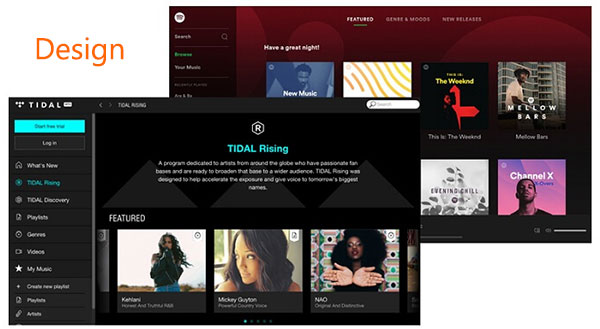
There is a lot of debate on how much difference you can hear between lossy and lossless music. While that seems like a no-brainer in terms of quality, it’s not a slam dunk, as the numbers indicate. By comparison, Tidal HiFi is 1411kbps and uses the FLAC lossless format.
#Tidal vs spotify 320kbps#
Spotify Premium (their top tier) is 320kbps and uses the AAC lossy format for their music.
#Tidal vs spotify free#
Spotify has a free version that has much lower bitrates and commercials. Note: I am comparing the paid version of both apps. Offering both music and podcasts, Spotify is a great way to get all your content in one place. Spotify is almost synonymous with music streaming. Offering an extensive catalog of music and artists and lossless playback, they have found a place in the hearts of many AV enthusiasts. In recent years, Tidal has risen in popularity. While I love the nostalgia of CDs, they are not great at playlists. If you are like me, you have playlists for every mood. Those looking for music not charting on a Top 10 might like SoundCloud.Streaming services are convenient, and they give you access to a catalog of millions of songs and artists across every genre. Family plans start at $14.99 a month for up to five members, students can pay as low at $4.99 a month, and there's also a military subscription which starts at $5.99 a month. After that individuals pay $9.99 a month, or $8.49 a month for six months pre-paid for a regular account, or $19.99 a month for a high-fidelity sound quality version, or $16.99 a month for six months pre-paid. There is a 30-day free trial, and a six month offer currently online for new Sprint customers granting them six months free. There are multiple pricing plans on Tidal. However, Tidal is the streaming service with the most exclusive songs and music videos, including Beyoncé's Lemonade, which can't be found on any other service. Similarly to the other options, Tidal offers ad-free, unlimited listening and millions of songs for $9.99 a month. Owned by Jay Z, Tidal pays their artists the highest royalties over any other streaming service. But, Amazon Music pairs with the Amazon Echo, making it perfect for listening around the house.

Like Spotify, Apple, and Google, users can listen to their favorite songs and new releases, along with a family plan.

With a Prime membership, users already have two million songs free at their fingertips, but if you want access to their collection of tens of millions songs, users can shell out an extra $7.99 a month – $9.99 if you don't have Prime.

If you have an Amazon Prime membership, you almost have to consider Amazon Music.Īmazon Music is the best option for die-hard Amazon fans.
#Tidal vs spotify for free#
You can listen to radio stations for free on Google Play, but accounts are priced similarly to Apple Music: $9.99 a month for single users, $14.99 a month for families of six. However, Google Play offers curated playlists structured by a feeling, making it easy to boost your mood or quiet down before bed. Google Play Music boasts an incredible amount of playlists, but is a little less organized than Spotify and Apple. While Google Play is similar to it's competitors in song selection, service and pricing, it sets itself apart from other streaming services because it is compatible with YouTube Red, which makes it easy to add even more music, but also videos. Spotify makes it easy to discover new songs, your favorite old jams, and playlists for holidays and special occasions, making it an incredibly user-friendly service. For $14.99, users can add up to six people to their account. Spotify is an especially great option for families. It's ad-free and unlimited, so even the most indecisive listeners can find a song-or podcast-that speaks to them. And for good reason, for $9.99 a month-or $4.99 with a student discount-users have access to over 30 million songs, curated playlists based on your music taste, and featured playlists of popular artists and genres. There's no question that when it comes to music streaming services, Spotify is the most well known. But with so many options available, which one gives listeners the most bang for their buck for their individual needs and taste? Let's find out. Music streaming services changed all of that, letting you pick a tune at will, at any time, anywhere.

Even just a couple years ago, you had to actively put the songs you wanted to hear on your device in advance. Not long ago, the best way to bring your favorite tunes on the go was to commit to one CD, pop it into a player, and if you were lucky, hope the disc wouldn't skip.


 0 kommentar(er)
0 kommentar(er)
